Before the Trip
The Grade 11 excursion was significant to us, since in school, we are all so busy with studies that we don’t get enough time to bond with our batchmates and friends. An excursion is the perfect way to take time off from our school lives and truly enjoy the company of friends and teachers in a completely different environment.
Usually, waking up at 4 am would have us all sleepy and tired and want to lay back in bed. But on the morning of the excursion, we were up and ready to leave, thrilled for what was ahead of us. Even though some of us were anxious as we had never been so far away from home without our family, our teachers and friends made us feel right at home. Before the trip, while reading the itinerary, we assumed we were going to just hop from one city to another and look around but the actual trip was much more than simply sight-seeing. Our days were filled with activities from dawn till dusk and some of the places we visited taught us a lot. For example, we learnt about Jallianwalah Bagh as part of our syllabus, but to be there in real life, was a surreal experience. All together, we had a wonderful time and are already looking forward to our next excursion for such meaningful experiences.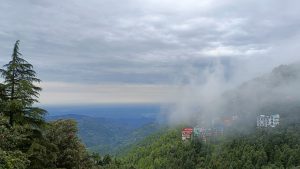
Dharamshala
Dharamshala is a city situated on the lower slope of the Himalayas, in the Kangra Valley. The area was once under the Sikh empire and later under British rule from 1848. Now, it is known for its Tibetan culture, as it houses the exiled Tibetan government and His Holiness, the Dalai Lama.
A pale mist snaked through the winding roads of the town and it was cold, a deep chill settling into our bones, even as our watches told us it was 2 o’clock in the afternoon. Pine trees rose up from the sides of the mountain, large looming figures, made all the more majestic by the mist. As we trudged through the town, weighed down slightly by our backpacks and hoodies, we saw up close the yellow walls and red roofs of buildings that we had seen a small glimpse of through the windows of our buses.
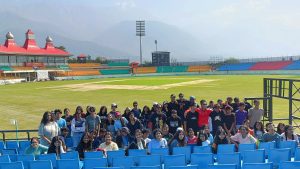
Norbulingka Institute
Norbulingka Institute is a unique institution located in Dharamshala dedicated to the preservation of Tibetan arts and culture. Norbulingka, which means Jewel Park in Tibetan, takes its name from the Dalai Lama’s summer palace in Lhasa, which was renowned for its beautiful gardens and was also a centre of religious art. The Norbulingka Institute in Dharamshala was founded in 1990 as a centre where traditional arts can flourish, preserving artistic lineages which have been passed down for centuries from masters to students. It also provides jobs and training for those living in the Tibetan diaspora of India.
When we were there we came across beautiful displays of dolls and other artistic pieces in the Losel Doll museum. There were scenes from Tibetan plays and scriptures, intricate depictions of certain ancient Buddhist rituals and figurines of historical significance among the dolls displayed. One exhibit, a simple rendition of two types of boats used in Tibet to carry goods across rivers and other water bodies, made naked the tragedy of lost culture and land that the Tibetan people had to suffer. The sheer level of craftsmanship and beauty coupled with the historical significance of the displays in the doll museum were heartening to see. After all, to keep the past alive in the aftermath of violence is a difficult yet important task.
We went to the Buddha temple in the Institute, in which was a tall seated Buddha idol made with gilded metal. Long Thangka paintings and wall frescoes adorned the peaceful temple. We sat for a while, simply to listen to the faint creaking cicadas and the stray bird twittering on the trees around the temple, a moment of tranquillity sorely needed after the long tiresome days of travel before and ahead of us.
There was also The Norbulingka Art Shop, which sold various stunning arts and crafts of Tibetan culture. Everyone was absolutely amazed by the sheer magnificence of the place and the intricate Thangka arts and crafts that it displayed.
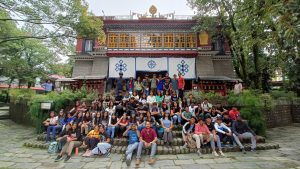
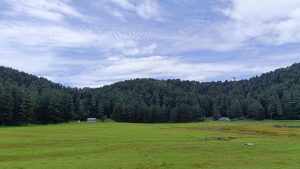
Namgyal Monastery
The Namgyal Monastery in McLeodganj, Dharamshala is the private monastery of His Holiness, the 14th Dalai Lama. After the invasion of Tibet by the People’s Liberation Army in 1959, approximately one hundred thousand Tibetans fled into the neighbouring countries of Nepal, Bhutan and India. The Indian government had agreed to provide asylum to the Dalai Lama and his followers in India along with permission to establish a government-in-exile in the northern hill station of Dharamshala, Himachal Pradesh. The Namgyal Monastery of Tibet was re-established near the Dalai Lama’s residence where it continues its teachings with about 200 monks. Within Namgyal Monastery, we visited the Kalachakra temple, containing idols of Tibetan Gods and Goddesses such as Avalokiteshvara, Manjushri, Vajrapani,Tara and Guru Padmasambhava. Nearby, was the Buddha temple, where His Holiness gives his sermons. We also saw several Tibetan Buddhist manuscripts — ‘pothis’ — stored in the temple.
Throughout our stay in Dharamshala and Dalhousie, we came across Tibetan or Indo-Tibetan markets. Colourful bracelets made of round shiny beads in light pinks, hazy lavenders, bright aquamarines and many more colours caught our eye as we made our way through the markets. There were small make-shift pop-ups selling earrings of all shapes, sizes and colours squeezed into the small space between other shops full of delicious looking pastries, knick-knacks and golden Buddha statues.
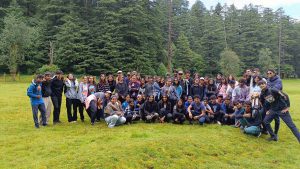
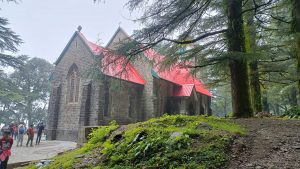
Dal Lake
There is a small lake, called Dal Lake near our hotel in Dharamshala, which we passed several times and even went for a walk around once, our feet squelching into the soft mud and the cold air wrapping us in a chilly blanket.
The word ‘dal’ (pronounced dull) means lake in several languages of the Western Himalayas. It is famous for its old Lord Shiva temple, on the bank, which is considered very sacred. According to legend, Maharishi Durvasa used to pray here.
The beautiful lake had greenish water and was surrounded by towering deodar trees. It was sunny that day, and a warm breeze refreshed us during our walk. The only sounds we heard were that of nature: lilting sweet bird calls, our own soft whispers and the ever present choir of cicada.
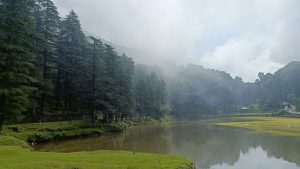

Dalhousie
Dalhousie, named after the British viceroy Lord Dalhousie is a town situated on the Dhauladhar range of the Himalayas. It is known for its British era buildings, churches and scenic views. Our tour buses ramped up their speed as the road tilted upwards and we left behind Dharamshala. The mist grew thicker too and the air colder. But once we reached our place of stay at early noon, the sky was a periwinkle blue and there was not a cloud in sight. We gazed from the terrace of the hotel into the mountains tumbling into hills and then valleys, a river, pine trees turning into the usual oaks and teaks. On the far side of the horizon, at the very end of our vision the earth seemed to become one with the sky and we felt very small, like specks of dust or insects at the vastness of the world before us.
On the next night, our last one in Dalhousie, a feeling of bitter-sweet finality was in the air. The night sky was dotted with stars in a way that we hardly ever get to see in Bangalore and a local artist was playing Hindi songs, old and new, on a guitar. Some of us reminisced on the trip so far while others looked ahead. We will soon leave the known world of school and enter the much more ambiguous space of adulthood.
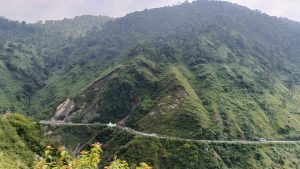

Amritsar
Visiting the Golden Temple and Jallianwala Bagh in Amritsar was a fantastic experience that left a lasting impact. The Golden Temple, or Harmandir Sahib, was absolutely breathtaking. The moment we stepped onto the marble walkway, we were greeted by the soothing sounds of kirtan, which added to the serene atmosphere. The sight of the Golden Temple, with its golden façade, was truly awe-inspiring. Walking along the Amrit Sarovar, the sacred pool surrounding the temple, was a peaceful experience. The volunteers serving langar, a free community meal, showcased the spirit of selfless service that the Sikh faith promotes.
Our visit to Jallianwala Bagh was also significant in its ability to transport us to a dark moment in Indian history. This historic site, now a peaceful garden, commemorates a tragic event during the Indian struggle for independence. Our history teacher explained the Amritsar massacre in 1919, which was a poignant and important history lesson. Standing in this place and seeing the memorial helped us connect with the sacrifices made by those who fought for our nation's freedom.

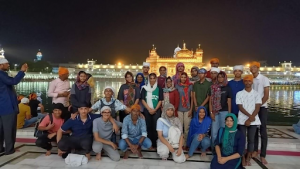


Our Takeaway
One would imagine that a week-long trip to Himachal would be fog, hills, bliss and enlightenment, and one wouldn’t be wrong, however, that isn’t completely true when a class of sixty Grade 11 students travels over two thousand kilometres away from home.
Amritsar’s prickly heat greeted us as we stepped foot in the north, as did kulchas and paneer gravies, but the misty town of Dharamshala awaited our arrival. Tempo travellers roared on winding roads, rain poured down to set the scene, and onion pakodas, round and chewy, hot and sprinkled with salt were devoured. Almost as if the rain and sputtering engines foreshadowed devastation, having finally arrived at a comfortable hotel, it came to our notice that a suitcase had rolled off the top of a vehicle on some road two hundred kilometres away and was gone. Forever. And our classmate, the owner of the suitcase, was two thousand kilometres away from home, shattered, belongings lost; there was uncertainty in the air. But that night, there were several knocks on her room door, and each time there was a new person offering clothes, hugs, and condolences.
Despite a rough first day, on the hills of Dharamshala, having arrived sore, having lost baggage, having gained baggage (the emotional kind), we breathed the air of the mountains, thick, cold, and mostly hazy with a tinge of pine.
Belgian stained-glass windows of a church amidst deodar forests spectated as we walked on kaleidoscopic pebbles and before we knew it, our days making memories in Dharamshala were over and we were headed to the hill station of Dalhousie, where piping hot tea accompanied by biscuits after a local shopping spree was so welcome.
Those seven days didn’t go by hiccup-free, but when do they ever? As in any narrative, conflict did arise, climax did unfold, and the action following smoothened things out. Spectators, the mist and altitude witnessed a class of teenagers being teenagers.
The Golden Temple stood majestic, a beauty before our eyes and the atmosphere around it left us deep in thought about spirituality, culture and tradition. The bustling streets of Amritsar were no less fascinating, colourful and with a personality of their own.
Steaming parathas for the flight back home tied a neat ribbon on this gift of a journey, one which taught us more than we can explain. We made bonds, reflected on bonds, and our bond as a class strengthened through our shared experiences. It was a journey we will always remember, for even though those seven days never failed to throw unannounced twists of fate at us, it did not fall short in any way of delivering sights and insights, of pure sublimity.
Grade 11
Head Start Educational Academy 2023-2024
